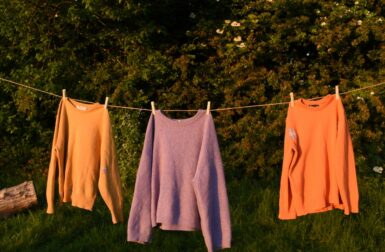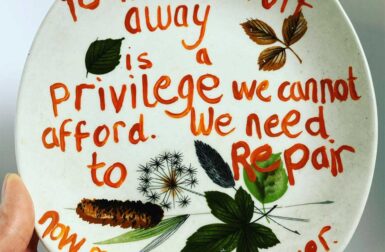Jump The Hedges is an award-winning sustainable design studio based in Belfast and founded by former adidas designer Síofra Caherty. The studio has a material- and waste-led approach to product creation that ensures waste material is fully utilized to create valuable and long-lasting products. Bags are created from reclaimed truck tarpaulin, airplane seat parts, and waste leather. Alongside creating bags, the studio leads workshops on sustainability with local schools and communities.
Tell me a little bit about your childhood, education, and background in terms of how you first became interested in creativity, design, and sustainability.
I am the youngest of five kids brought up in the countryside right on the Irish border. As a large family, sustainability was at the core of everything we did – however I didn’t recognize this at the time. I assumed all families composted, reused, and repaired! My family are all tradespeople or teachers, so my creativity, problem-solving, and ability to work with my hands came from them. I worked as a fashion designer for several years for smaller Irish brands and then for adidas in Germany. It was while I was at adidas that I saw an opportunity to combine fashion and sustainability. Up until that point, I had felt that my love for fashion and the environment was conflicting. I decided to leave adidas, move back home, and set up my own business with sustainability at its core.
How would you describe your project/product?
My products are material-led in that I use whatever material I can get my hands on. I enjoy working within constraints and I believe that this is where the most creative work is born. I use my work as a platform for sustainable awareness and alongside creating bags, I lecture on sustainable design and teach community outreach workshops.
What waste (and other) materials are you using, how did you select those particular materials and how do you source them?
I started off using the banner cloth that you see on the side of museums and building works hoardings. I noticed piles of them being replaced frequently around Belfast. While cycling home one day I spotted a trailer carrying a pile of them and at the traffic lights, I convinced the driver to drop some in my back garden. I made my MFA graduate collection from these banners. However, after a lot of use, I noticed that the banner cloth was not durable enough. At this point, I decided to try truck tarpaulin and started cold-calling haulage companies for waste tarps. I have now built up a supply chain of people I can call on when I need waste material. I source the waste leather from a local chair company and the airplane straps are industrial waste from the aerospace industry in Belfast.
When did you first become interested in using waste as raw material and what motivated this decision?
I noticed the abundance of waste materials around the city and how durable it was. I thought there had to be a way to use this material and it just seemed ridiculous to buy ‘recycled’ material when there was so much material already in existence. I studied an MFA in Multidisciplinary Design at Belfast School of Art and this acted as an incubation unit for me to explore different waste materials and a way to figure out how to start a business using these materials.
What processes do the materials have to undergo to become the finished product?
After sourcing the materials, I collect them, which means either borrowing a van or squeezing them into my own car – I managed to fit a 40-foot tarp into a Toyota Yaris once, believe it or not. Then I spread the tarp out and strip all the hardware off – all the metal can be recycled. After this, I cut it into smaller parts being careful to save interesting shapes and letters. Then I bring it to an industrial washer who washes it in collected rainwater.
What happens to your products at the end of their life – can they go back into the circular economy?
Both the problem and benefit with truck tarpaulin is that it is super durable and lasts for many years on the road. Unfortunately, it can only be repaired to a point and it eventually goes to landfill. My work is diverting it from landfill and keeping it away from there for a much longer period of time. Unfortunately, this material is not recyclable which makes it even more necessary to use it up!
How did you feel the first time you saw the transformation from waste material to product/prototype?
I felt really excited the first time I managed to successfully create something useful from waste material. There is so much opportunity in using waste material, we just need to adjust our mindset and approach when working with it.
How have people reacted to this project?
I began working with recycled materials six years ago when the upcycling and sustainability movement didn’t have the same traction it does now, so people were not fully on board at the beginning. In fairness, I don’t think I had gotten the cleaning quite right at the beginning either! I spent a lot of time with my products at market stalls explaining the material and the process. Slowly but surely I got some media attention and during COVID-19 everything took off as I was able to sell directly from my website.
How do you feel opinions towards waste as a raw material are changing?
I lecture part-time at NCAD in Dublin and every single fashion student I work with is either using waste or sustainable materials. There needs to be an emphasis in education on using waste materials, particularly hard-to-use ones like truck tarpaulins. Young designers need to be challenged and made to think outside the traditional way of designing as this is no longer a relevant approach. We have an abundance of waste material and we need to prioritize using this before using new material.
What do you think the future holds for waste as a raw material?
Perspectives have really changed over the past few years and people are much more open to and interested in products made from waste material. Increasingly consumers want to be more individual and there is nothing more unique than having an item made from waste material.



































